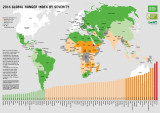How can African agriculture adapt to climate change: The impact of climate variability and climate change on water and food outcomes
Over the coming decades, global change will have an impact on food and water security in significant and highly uncertain ways, and there are strong indications that developing countries will bear the brunt of the adverse consequences, particularly from climate change. This is largely because poverty levels are high, and developing-country capacity to adapt to global change is weak.





